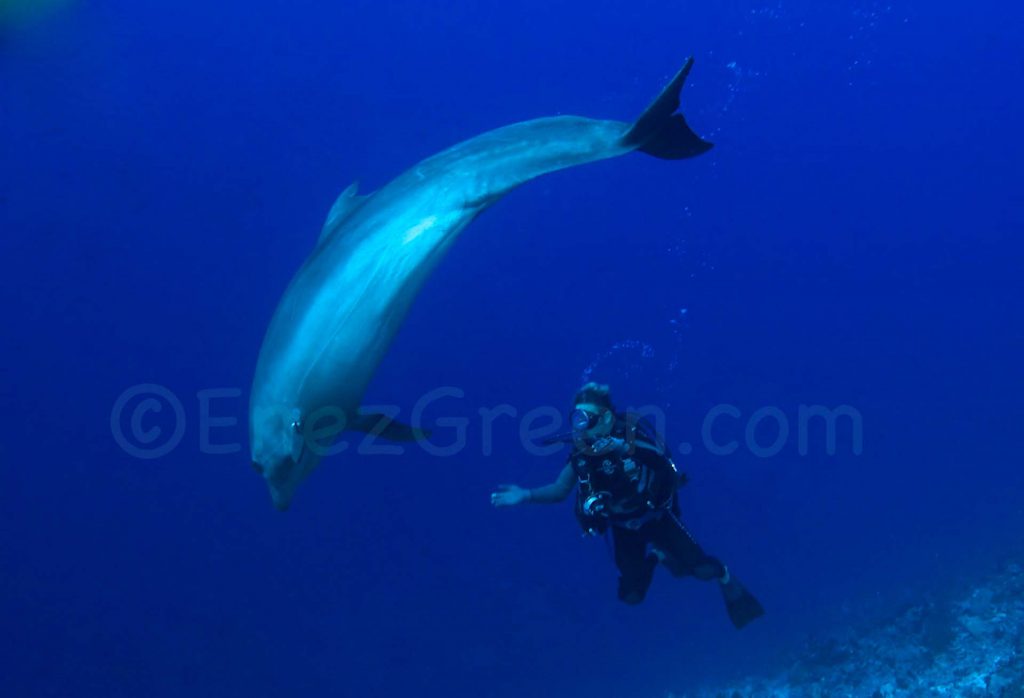A pioneer of diving in Rangiroa, Tuamotu islands
Yves Lefèvre has a profound love for the sea. He has been snorkelling in most corners of the world and always enjoys sharing his discoveries.
This fair-headed man who made his first dives in pools in Paris was by no means predestined for such a career path. After having taken courses in emergency assistance and completed his training as a diving instructor, he wandered on the Red Sea, in Indonesia and in the Pacific.
Discovering the marine biodiversity of the Tuamotu islands
However, things really started to happen in Rangiroa in 1984. At 20, Yves Lefèvre landed on the island with nothing more than a camping tent and already over 800 dives to his credit. He started a systematic prospection of the ocean floor, explores the passes and identifies the sites at depths that the local fishermen couldn’t reach, although they were excellent free divers.
The diver then realises how amazing the biodiversity of the place is. Fascinated by the remarkable concentration of pelagic wildlife, he decided to set up his own activity as animal guide and paves the way for leisure diving in the Tuamotu islands.
Rangiroa was thus the first atoll of the Tuamotu Archipelago to be ‘colonised’ by divers, whose numbers fortunately are still environmentally sustainable. In a matter of years, the island’s two passes, Avatoru and Tiputa, earned themselves a place among the top 10 diving destinations in the world.
Rangiroa, the best location for encounters with large predators
Tiputa is today the best location for divers in search of thrilling encounters with large predators. The aquanauts come from oceans all over the world to dive in the pass and watch tens of grey reef sharks (raira in Tahitian language) grouping together until forming ‘walls’. This concentration of sharks is the highlight of the dives. From the very beginning and until returning to the surface, there is never a dull moment. The encounters succeed to each other with bottlenose dolphins (Tursiops truncatus) welcoming divers on the way down to the bottom and the multiple appearances of barracudas and jacks, the dances of manta rays and flights of spotted eagle rays. And along the outer fringe reef, aquanauts can watch the classical bunch of humpback snappers, turtles, Napoleon fish, morays, triggerfish, squirrel fish and other surgeonfish.
The deep blue waters of the Tuamotu islands
Whether it is along the outside reef or in the open sea, in the pass or in the lagoon, divers are in constant amazement, the more so because diving conditions are most ideal. Besides average water temperature of 27 °C, the Tuamotu seabed is indeed renowned for the remarkable luminosity and transparency of its waters. The blue seabed of the Tuamotu is an image that is etched forever in the memories of divers. The images of these amazing encounters reappear as if by magic a long time after. It is not an understatement to say that in Rangiroa, a close bond appears to have developed between the aquatic wildlife and divers, at least for those who were more attentive, and maybe the weirdest of them!
Yves Lefèvre, Sensitisation through underwater movies
Yves Lefèvre is specialised in approaching the pelagic wildlife and accompanies underwater photographers and cameramen from the world over. Amazing images have been shot by the prestigious audiovisual crews of the Calypso, of Luc Besson’s movie, Atlantis, or even for Nicolas Hulot’s show on French TV, Ushuaïa. Famous photographers such as David Doubilet regularly dive in the passes to capture some magical encounters.
Courtship displays and cetaceans feeding their offspring
Yves Lefèvre is happy to welcome his colleagues in Polynesia but he also produces his own images through the Polynesian subsidiary of Cinémarine, whose founding chairman is none other than Christian Pétron, the illustrious filmmaker and chief cameraman who, amongst others, supervised the shooting of underwater footage for ‘Le Grand Bleu’ (The Big Blue).
He hence participated as chief cameraman in the making of documentary films like ‘Le lagon des raies Manta’ (Manta rays in the lagoon), ‘La danse des Baleines’ (The dance of the whales), and has namely shot beautiful images with Christian Pétron for ‘Les animaux amoureux’ (Animals in love), by Laurent Charbonnier. Equipped with HD cameras and rebreathers, the cameramen have captured amazing courtship displays of Tursiops in the Tiputa pass at Rangiroa as well as poignant scenes of humpback whales feeding their offspring at Rurutu, in the Southern Islands.
‘Our aim is to ignite awareness of ecological issues among spectators. We rely on beautiful images to sensitise the general public and familiarise them with the maritime world. This little-known and fragile world must be protected at all costs,’ says Yves Lefèvre.
Polynesian sharks under high protection
Due to his involvement in Polynesia, Yves Lefèvre pays special attention to tourism development and the preservation of seabeds. ‘In over 20 years, economic development has exerted considerable pressure on the marine ecosystems of Polynesia. A few years back, populations of sharks have been depleted in certain atolls of the Tuamotu. In fact, I welcome the efficient efforts of the government of Polynesia, which ordered a ban on shark finning despite a difficult socio-economic context.’
A law to ban shark finning
Since 12 April 2006, an order bans shark finning in entire French Polynesia and of shark feeding in all lagoons, passes and within a 1 km radius from the centre of passes. Moreover, the trade and possession of any parts of a shark, including in jewellery, are now prohibited. It should be noted that nearly 7.5 tons of dried shark fins have been exported. This law thus puts a term to this unacceptable massacre and is indeed a model which has been followed by other renowned diving destinations like Palau and the Bahamas.



